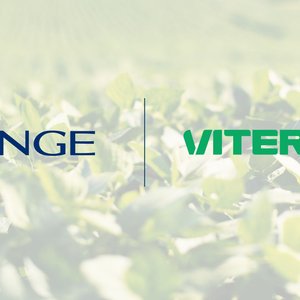The Agricultural Research Service (ARS) and its partners are working to develop cost-effective feeds that will help the U.S. aquaculture industry expand and capture a greater share of the world market for fishery products.
ARS researchers are primarily exploring plant-based alternatives to fishmeal and fish oil, and investigating solutions to issues with palatability, digestability, and anti-nutrients that are common with plant-based ingredients. Soybeans, for example, contain phytic acid, a naturally occurring compound that can prevent farmed fish from absorbing phosphorus, iron, and other nutrients from their feed.
One approach, being investigated by ARS and university scientists in Auburn, Alabama, is to spray plant-based feeds with phytase, a commercially available enzyme that destroys phytic acid and is used with pig and other livestock feeds. In trials, catfish that ate a phytase-treated commercial diet had higher red blood cell and hemoglobin counts than fish given untreated feed, according to Benjamin Beck, a physiologist in ARS’s Aquatic Animal Health Research Unit in Auburn. Catfish in the phytase group also grew faster, suggesting the approach could lead to improved health and productivity in commercially raised catfish, which fetched a U.S. farmgate value of $350 million in 2016. ARS and university scientists in Stoneville, Mississippi, recently found that giving fish more than 500 phytase units (a measurement of enzyme activity) showed little benefit. This suggests catfish farmers could avoid the cost of using more phytase than is necessary.
In Idaho, ARS scientists and their collaborators are taking a different tack to improve the nutrition of farm-raised fish. Instead of customizing the feed to suit the fish, they are, in a sense, customizing the fish to suit the feed.
Led by Ken Overturf, an ARS geneticist in the Small Grains and Potato Germplasm Research Unit in Hagerman, the team has selectively bred a strain of rainbow trout that will eat an all-plant, high-soybean diet and grow efficiently on it.
In trout and other members of the salmonid family, a long-term diet of soy or other plant-based aquafeeds can lead to reduced growth and an inflammatory intestinal condition called enteritis, among other complications. However, in feeding trials, the soy-tolerant fish strain developed twice as fast as nontolerant rainbow trout lines and showed no signs of enteritis.
The advance is tied to the team’s identification and analysis of multiple genes and physiological pathways enabling the trout strain to digest and metabolize soy proteins for muscle growth. The research opens the door to a strategy that could reduce dependency on fishmeal-based diets for all commercially produced carnivorous fish.
Soy isn’t the only potential alternative aquafeed ingredient. ARS scientists, including Overturf and Rick Barrows (ARS retired), are also evaluating the potential of flaxseed, barley protein concentrate, poultry processing remains, and dried distillers’ grains with solubles, a byproduct of ethanol-production.
Other candidate ingredients include discarded tree nuts like pistachios, single-celled organisms like yeasts, meals made of insect larvae, and algae. Biodiesel production from algae uses the algal carbohydrates but leaves a protein-rich coproduct that was readily consumed by California yellowtail and white seabass in feeding trials. On a related front, algae-based feeds are being examined as sources of omega-3 fatty acids. Consuming omega-3 fatty acids from fish oil and other foods can offer us health-promoting benefits, like reduced risk of heart disease.
In addition to collaborating with commercial feed manufacturers and others in the private sector, ARS researchers also partner with experts from stakeholder groups, academia, and state and federal agencies, like the National Oceanic and Atmospheric Administration via its Alternative Feeds Initiative. Established in November 2007, the initiative seeks to “identify alternative dietary ingredients that will reduce the amount of fishmeal and fish oil contained in aquaculture feeds while maintaining the important human health benefits of farmed seafood.”
Developing and evaluating such ingredients is only part of the ARS research equation, though. Here are a few others:
• Recommendations on attaining dissolved oxygen levels in pond water that will maintain catfish health.
• Digestibility evaluations for different kinds of fish feed ingredients, with the information stored in an ARS-developed nutrient availability database.
• A chitosan-based treatment that, when combined with a meat-preparation procedure known as vacuum tumbling, prolongs the shelf life, flavor, and quality of refrigerated catfish fillets. Chitosan is a component of shellfish.
• Demonstration that dry cooking methods (baking, broiling, microwaving) do not alter the fatty acid levels of farm-raised salmon and that twice-weekly consumption provides the recommended levels of omega-3 fatty acids thought to reduce the risk of heart disease.
• Genetic studies to increase long-chain fatty acid levels in farmed rainbow trout and assess their potential health benefits in consumers through clinical trials. The U.S. Department of Agriculture’s National Institute of Food and Agriculture is supporting the effort, which includes examining the effects of finishing diets on trout fatty acid levels.
Genetics also figure prominently in meeting the dietary needs of farm-raised fish and, in turn, the health and well-being of consumers, notes Caird Rexroad, ARS national program leader for aquaculture. This includes breeding “fish-friendly” crops with better feed digestibility and developing new fish lines that are especially adept at using plant-based feeds as healthful sources of protein and oil.
“Aquaculture has tremendous potential to provide healthy protein sources to a growing global population, and the United States has the natural resources and agricultural know-how, including genetic improvement technologies, to help make this happen,” says Rexroad.
Published in USDA ARS Online Magazine, January 2018










